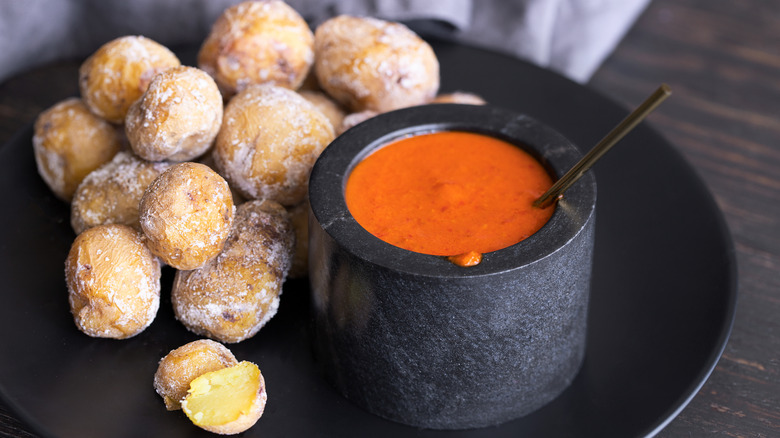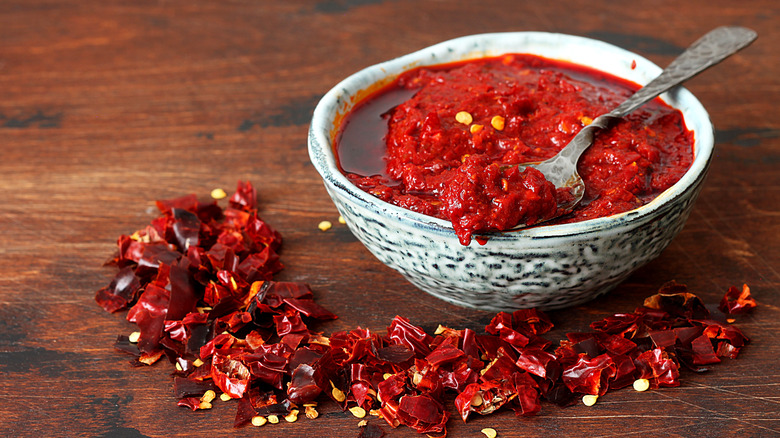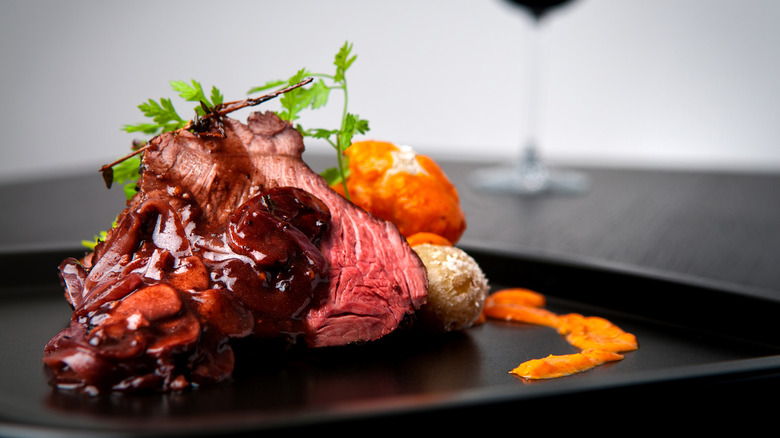Mojo Picón: The Spanish Sauce You Should Start Slathering On Potatoes
When Americans hear the word "condiment," they tend to think of the classics: ketchup, mustard, and mayonnaise. But, in reality, a condiment, by definition, is anything that makes food taste better, per Merriam-Webster. The most basic condiment, then, is probably salt but extends into a world of sauces, chutneys, preserves, and dressings. It seems most condiments get their fifteen minutes of fame at some point in history. In the 1970s, horseradish sauce was huge. In the '80s, Americans fell in love with balsamic vinegar. By the '90s, it seemed everyone was eating salsa, according to Food & Wine. By the early 2000s, Sriracha was creeping into people's food spheres before practically turning into a food revolution. Today, chili crisp is hot in more than one way, with globally inspired barbeque sauces quickly coming onto the scene, according to The Kitchn.
While some popular condiments are 100% American (think Tabasco), most are steeped in international history, inspired by and coming from all corners of the world. Even ketchup, which seems about as American as apple pie, has roots in Vietnam, according to the culinary website Matador Network. One country that has given the world some of the best food flavor enhancers is Spain. From this western European gem has come Romesco sauce, salsa verde, and mojos, per The Spruce Eats. According to the blog The Spanish Radish, mojo rojo and mojo verde offer food a delicious, acidic addition, but it's mojo picón that will really spice up your dishes.
A Spanish sauce with spice
According to Bon Appetit, mojo picón comes from the exquisite Canary Islands, a group of eight Spanish islands closer to the coast of northern Africa than Spain. The name "mojo" comes from a neighbor to the northeast, Portugal, whose word for "sauce" is "molho." This is likely because some of the island's earliest residents came from Madeira, an island off the coast of Portugal, per Gran Canaria. Mojo picón is a combination of picón peppers, cayenne pepper, garlic, salt, cumin, smoked Spanish paprika, red wine vinegar, and sunflower oil (via Saveur). There are plenty of substitutions and adjustments that can be made, such as using red jalapenos as the peppers, sherry vinegar, and olive oil (per Bon Appetit), but the basic recipe is the same.
It is suggested that the elements of this sauce are a true melting pot, so to speak, with the paprika coming from Spain, the cumin hailing from Africa, and the spicy peppers coming to Europe from the Americas, per Marca Canaria. Mojo Picon isn't to be confused with Cuban and Puerto Rican mojo sauces, which are typically used as marinades, but Gran Canaria suggests they may have been influenced by the famous Canary Island sauces.
Potatoes and so much more
In the Canary Islands, Mojo Picón is often served with roasted, salted potatoes as a tapa, and even in your own kitchen, this is a perfect way to enjoy this savory condiment. Bon Appetit advises that, upon making your mojo sauce, be sure to leave some texture. A mortar and pestle will probably give you a result that most resembles what you would find in the Canary Islands, but it's also time-consuming. So, a blender or food processor is also fine as long as the mixture is not blended into a completely smooth sauce. Leave that for your hummus and salad dressings.
The Spruce Eats suggests that mojo picón is also delicious served with fish and meat. Bon Appetit takes it further, recommending you should treat the sauce like you would any of your favorite condiments: slather it on everything savory in your refrigerator, vegetables and meats alike. Sharing with others is optional.


